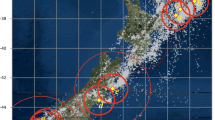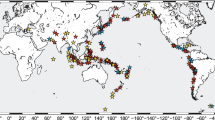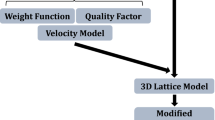Abstract
The recent strong earthquakes in Central Italy allow for a comparative analysis of their aftershocks from the viewpoint of the Unified Scaling Law for Earthquakes, USLE, which generalizes the Gutenberg–Richter relationship making use of naturally fractal distribution of earthquake sources of different size in a seismic region. In particular, we consider aftershocks as a sequence of avalanches in self-organized system of blocks-and-faults of the Earth lithosphere, each aftershock series characterized with the distribution of the USLE control parameter, η. We found the existence, in a long-term, of different, intermittent levels of rather steady seismic activity characterized with a near constant value of η, which switch, in mid-term, at times of transition associated with catastrophic events. On such a transition, seismic activity may follow different scenarios with inter-event time scaling of different kind, including constant, logarithmic, power law, exponential rise/decay or a mixture of those as observed in the case of the ongoing one associated with the three strong earthquakes in 2016. Evidently, our results do not support the presence of universality of seismic energy release, while providing constraints on modelling seismic sequences for earthquake physicists and supplying decision makers with information for improving local seismic hazard assessments.










Similar content being viewed by others
References
Baiesi, M., & Paczuski, M. (2004). Scale-free networks of earthquakes and aftershocks. Physical Review E, 69, 066106. doi:10.1103/PhysRevE.69.066106.
Bak, P., Christensen, K., Danon, L., & Scanlon, T. (2002). Unified scaling law for earthquakes. Physical Review Letters, 88, 178501–178504.
Bak, P., & Tang, C. (1989). Earthquakes as a self-organized critical phenomenon. Journal of Geophysical Research, 94, 15635–15637.
Ben-Zion, Y. (2008). Collective behavior of earthquakes and faults: continuum-discrete transitions, progressive evolutionary changes, and different dynamic regimes. Revues of Geophysics, 46(4), RG4006. doi:10.1029/2008RG000260.
Bufe, C. G., & Varnes, D. J. (1993). Predictive modeling of the seismic cycle of the greater San Francisco Bay region. Journal of Geophysical Research, 98, 9871–9883.
Christensen, K., Danon, L., Scanlon, T., & Bak, P. (2002). Unified scaling law for earthquakes. Proceedings of the National Academy of Sciences, 99(suppl 1), 2509–2513.
Davidsen, J., Gu, C., & Baiesi, M. (2015). Generalized Omori-Utsu law for aftershock sequences in southern California. Geophysical Journal International, 201(2), 965–978.
Davis, S. D., & Frohlich, C. (1991). Single link cluster analysis of the earthquake aftershocks: decay laws and regional variations. Journal of Geophysical Research, 96, 6335–6350.
Davis, C., Keilis-Borok, V., Kossobokov, V., & Soloviev, A. (2012). Advance prediction of the March 11, 2011 Great East Japan Earthquake: A missed opportunity for disaster preparedness. International Journal of Disaster Risk Reduction, 1, 17–32. doi:10.1016/j.ijdrr.2012.03.001.
Gardner, J., & Knopoff, L. (1974). Is the sequence of earthquakes in S. California with aftershocks removed Poissonian? Bulletin of the Seismological Society of America, 64(5), 1363–1367.
Gruppo di Lavoro (2004). Catalogo parametrico dei terremoti italiani, versione 2004 (CPTI04). INGV, Bologna. http://emidius.mi.ingv.it/CPTI04/.
Gutenberg, B., & Richter, C. F. (1944). Frequency of earthquakes in California. Bulletin of the Seismological Society of America, 34(4), 185–188.
Hainzl, S., & Christophersen, A. (2016). Comment on Revisiting the 1894 Omori aftershock dataset with the stretched exponential function by A. Mignan. Seismological Research Letters, 87, 1130–1133. doi:10.1785/0220160098.
Keilis-Borok, V. I. (1990). The lithosphere of the Earth as a nonlinear system with implications for earthquake prediction. Reviews of Geophysics, 28(1), 19–34.
Keilis-Borok, V. I., & Soloviev, A. A. (Eds.). (2003). Nonlinear dynamics of the lithosphere and earthquake prediction (p. 337). Heidelberg: Springer.
Kossobokov, V.G. (2005). Earthquake prediction: Principles, implementation, perspectives, in: Earthquake prediction and geodynamic processes. (Computational Seismology, Issue 36, Part 1), Moscow, GEOS (in Russian).
Kossobokov, V. G. (2013). Earthquake prediction: 20 years of global experiment. Natural Hazards, 69(2), 1155–1177. doi:10.1007/s11069-012-0198-1.
Kossobokov, V. G., Lepreti, F., & Carbone, V. (2008). Complexity in sequences of solar flares and earthquakes. Pure and Applied Geophysics, 165, 761–775. doi:10.1007/s00024-008-0330-z.
Kossobokov, V. G., & Mazhkenov, S. A. (1994). On similarity in the spatial distribution of seismicity. In D. K. Chowdhury (Ed.), Computational Seismology and Geodynamics, 1 (pp. 6–15). Washington DC: AGU, The Union.
Kossobokov, V., & Nekrasova, A. (2012). Global seismic hazard assessment program maps are erroneous. Seismic Instruments, 48(2), 162–170. doi:10.3103/S0747923912020065.
Kossobokov, V., Peresan, A., & Panza, G. F. (2015). Reality check: seismic hazard models you can trust. EOS, 96(13), 9–11.
Kossobokov, V. G., & Romashkova, L. L. (2005). Seismicity dynamics prior to and after the largest earthquakes worldwide, 1985–2000. In D. K. Chowdhury (Ed.), Computational seismology and geodynamics (Vol. 7, pp. 138–160). Washington D.C.: AGU.
Lepreti, F., Kossobokov, V. G., & Carbone, V. (2009). Statistical properties of solar flares and comparison to other impulsive energy release events. International Journal of Modern Physics B, 23(28–29), 5609–5618.
Mignan, A. (2015). Modeling aftershocks as a stretched exponential relaxation. Geophysical Research Letters, 42, 9726–9732. doi:10.1002/2015GL066232.
Mignan, A. (2016a). Revisiting the 1894 Omori aftershock dataset with the stretched exponential function. Seismological Research Letters. doi:10.1785/0220150230.
Mignan, A. (2016b). Reply to “Comment on ‘Revisiting the 1894 Omori Aftershock Dataset with the Stretched Exponential Function’ by A. Mignan” by S. Hainzl and A. Christophersen, Seismological Society of America, 87, 1134–1137. doi:10.1785/0220160110.
Nava, F. A., Marquez-Ramırez, V. H., Zuniga, F. R., & Lomnitz, C. (2017). Gutenberg-Richter b-value determination and large-magnitudes sampling. Natural Hazards, 87, 1–11. doi:10.1007/s11069-017-2750-5.
Nekrasova, A.K. (2008). Unified Scaling Law for Earthquakes: Application to seismically active regions of the world. (PhD. thesis), M.V. Lomonosov Moscow State University, Moscow. (in Russian).
Nekrasova, A.K. (2013). Estimation of seismic hazard and risks for Italy based on Unified scaling law for earthquakes. ICTP Interim Report, Miramare–Trieste, September 2013.
Nekrasova, A. K., & Kosobokov, V. G. (2006). Unified scaling law for earthquakes in the Lake Baikal region. Doklady Earth Sciences, 407A(3), 484–485.
Nekrasova, A. K., & Kosobokov, V. G. (2016). Unified scaling law for earthquakes in Crimea and Northern Caucasus. Doklady Earth Sciences., 470(2), 1056–1058.
Nekrasova, A., & Kossobokov, V. (2002). Generalizing the Gutenberg–Richter scaling law. EOS Trans AGU., 83(47), 62–0958.
Nekrasova, A. K., & Kossobokov, V. G. (2005). Temporal variations in the parameters of the Unified Scaling law for earthquakes in the eastern part of Honshu Island (Japan). Doklady Earth Sciences, 405, 1352–1356.
Nekrasova, A., Kossobokov, V., Parvez, I. A., & Tao, X. (2015). Seismic hazard and risk assessment based on the unified scaling law for earthquakes. Acta Geodaetica et Geophysica, 50(1), 21–37. doi:10.1007/s40328-014-0082-4.
Nekrasova, A., Kossobokov, V., Perezan, A., Aoudia, A., & Panza, G. F. (2011). A multiscale application of the Unified scaling law for earthquakes in the Central Mediterranean area and Alpine region. Pure and Applied Geophysics, 168, 297–327. doi:10.1007/s00024-010-0163-4.
Nekrasova, A., Peresan, A., Kossobokov, V.G. & Panza, G.F. (2014). Chapter 7: A new probabilistic shift away from seismic hazard reality in Italy? In: Aneva, B. & Kouteva-Guentcheva, M. (Eds.), Nonlinear Mathematical Physics and Natural Hazards, Springer Proceedings in Physics, 163, 83–103. http://dx.doi.org/10.1007/978-3-319-14328-6_7.
Okubo, P. G., & Aki, K. (1987). Fractal geometry in the San Andreas fault system. Journal of Geophysical Research, 92, 345–355.
Omori, F. (1894). On after-shocks of earthquakes. Journal of the College of Science, Imperial University of Tokyo, 7, 111–200.
Panza, G. F., Kossobokov, V., Peresan, A., & Nekrasova, A. (2014). Chapter 12. Why are the standard probabilistic methods of estimating seismic hazard and risks too often wrong? In M. Wyss & J. Shroder (Eds.), Earthquake Hazard, Risk, and Disasters (pp. 309–357). London: Elsevier.
Parvez, I. A., Nekrasova, A., & Kossobokov, V. (2014). Estimation of seismic hazard and risks for the Himalayas and surrounding regions based on unified scaling law for earthquakes. Natural Hazards, 71(1), 549–562. doi:10.1007/s11069-013-0926-1.
Reasenberg, P. (1985). Second-order moment of Central California seismicity, 1969–1982. Journal of Geophysical Research, 90, 5479–5495.
Romashkova, L., Kossobokov, V. & Turcotte, D. (2000). Seismic cascades prior to and after recent largest earthquakes worldwide. Eos Trans. AGU, 81 (48), Fall Meet. Suppl., Abstract NG62C-09, 2000: F564–F565.
Rovida, R. Camassi, P. Gasperini and M. Stucchi (eds.) (2011). CPTI11, the 2011 version of the Parametric Catalogue of Italian Earthquakes. Milano. http://emidius.mi.ingv.it/CPTI. Doi: 10.6092/INGV.IT-CPTI11.
Utsu, T., & Ogata, Y. (1997). Statistical analysis of seismicity. In: Healy, J.H., Keilis-Borok, V.I. & Lee, W.H.K. (Eds), Algorithms for earthquake statistics and prediction. IASPEI Software Library, Vol. 6. Seismol. Soc. Am., El Cerrito. pp. 13–94.
Utsu, T., Ogata, Y., & Matsuura, R. (1995). The centenary of the Omori formula for a decay law of aftershock activity. Journal of Physics of the Earth, 43(1), 1–33.
Wyss, M., Nekrasova, A., & Kossobokov, V. (2012). Errors in expected human losses due to incorrect seismic hazard estimates. Natural Hazards, 62(3), 927–935. doi:10.1007/s11069-012-0125-5.
Zaliapin, I., & Ben-Zion, Y. (2013). Earthquake clusters in southern California I: identification and stability. Journal of Geophysical Research, 118(6), 2847–2864.
Zaliapin, I., & Ben-Zion, Y. (2015). Artifacts of earthquake location errors and short-term incompleteness on seismicity clusters in southern, California. Geophysical Journal International, 202, 1949–1968.
Zaliapin, I., & Ben-Zion, Y. (2016). A global classification and characterization of earthquake clusters. Geophysical Journal International, 207, 608–634.
Zaliapin, I., Gabrielov, A., Keilis-Borok, V., & Wong, H. (2008). Clustering analysis of seismicity and aftershock identification. Physical Review Letters, 101, 018501. doi:10.1103/PhysRevLett.101.018501.
Acknowledgements
We thank Ilya Zaliapin of Department of Mathematics and Statistics, University of Nevada Reno for providing the Matlab code for problem-oriented seismic cluster analysis and the two anonymous reviewers for their valuable comments and suggestions that helped improving justification of our conclusions. The study was supported by the Russian Science Foundation Grant Nos. 15-17-30020 (in the part of statistical analysis of the best fit modeling) and 16-17-00093 (in application of USLE based methodologies).
Author information
Authors and Affiliations
Corresponding authors
Rights and permissions
About this article
Cite this article
Kossobokov, V.G., Nekrasova, A.K. Characterizing Aftershock Sequences of the Recent Strong Earthquakes in Central Italy. Pure Appl. Geophys. 174, 3713–3723 (2017). https://doi.org/10.1007/s00024-017-1624-9
Received:
Revised:
Accepted:
Published:
Issue Date:
DOI: https://doi.org/10.1007/s00024-017-1624-9




